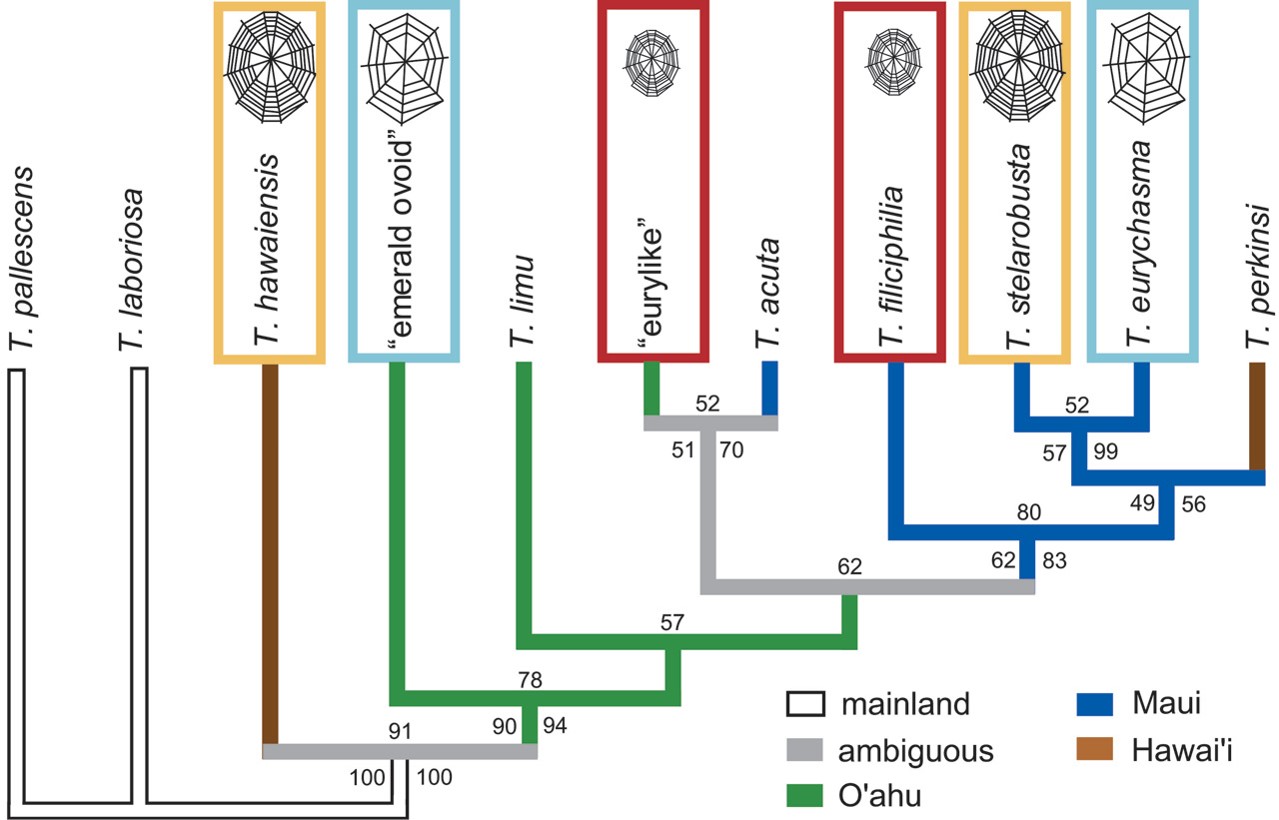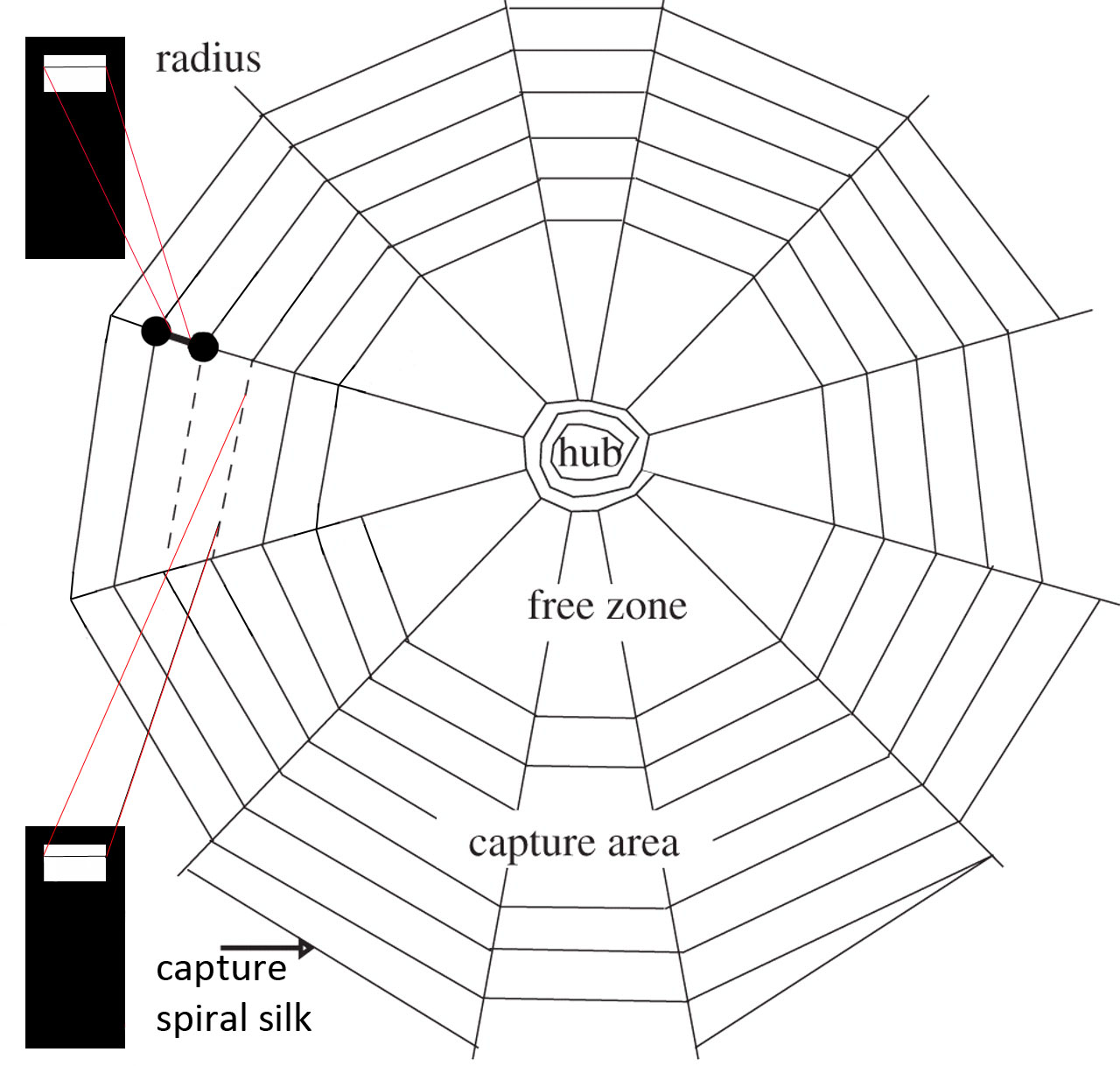About This Project
Silks are the toughest natural materials and spiders use them to build both its home and restaurant. Orb web shape diversified in a rapid, predictable fashion during evolution of endemic Hawaiian spiders. We aim to characterize their silk properties to test if biomaterials evolve as quickly and predictably as behaviors during adaptive radiation. This will provide important insight into the evolution of animal form and function and aid the development of spider silk-inspired fibers and adhesives.
Ask the Scientists
Join The DiscussionWhat is the context of this research?
Tetragnatha spiders rapidly evolved new web shapes during adaptive radiation in Hawaii. Relatives on the same island diversified webs while converging with independent species across different islands. Orb weavers use two silks in webs: Dragline silk is the web’s backbone, and functions in stopping flying insects due to its toughness and high energy dissipation. Glue-coated capture silk is stretchy and very sticky for prey retention. Spider silks' incredible properties interact with web architecture to determine the insects caught by webs. But can silk properties change as quickly as behaviors during rapid evolutionary radiations? Characterizing silk chemical and physical properties in these unique Hawaiian spiders will help us answer this question.
What is the significance of this project?
Spider silk shows great potential for medical, military and textile industries due to its unique mix of high strength and extensibility, biodegradable nature and biocompatibility. We aim to study diversification of this biomaterial during adaptive radiation, linking form and function. Specifically we want to see if material properties can diverge or diversify as rapidly as web architectures among closely-related spiders on the same island, and if species in different islands are converging or evolving similar biomaterial properties as the behaviors. This project will help compare the evolvability of natural materials to behaviors and is important for understanding spider diversification, Hawaiian biodiversity, and developing new biomaterials that mimic spider silks impressive performance.
What are the goals of the project?
The funds will support travel to the field sites in the high mountains of Hawai'i for the PI and one undergraduate student.
We will collect orb webs from Tetragnatha in four islands of the archipelago, where species independently evolved similar web shapes. Capture spiral and dragline will be collected directly from each web. Dragline will also be reeled directly from the spiders’ spinnerets under controlled conditions. The mechanical properties of the silks will be measured at the University of Akron using a nano-tensile tester, and chemical composition measured using amino acid composition and NMR.
This work will contribute to the Master Thesis of the PI and is anticipated to yield one publication.
Budget
This research requires travel of two people to Hawai’i for collection of samples. Field season will be for two months. Collection work will be done for two weeks at each of the four locations in the Hawaiian archipelago. All samples will be brought back to the University of Akron where silks will be characterized using equipment present at the University and techniques standard to our lab.
Budget details:
Once in Hawai'i, inter-island flights will be covered by an external grant: $1000
Endorsed by
Meet the Team
Angela M. Alicea-Serrano
I received my bachelors degree in Science with a major in Integrative Biology from the University of Puerto Rico, San Juan. As an undergraduate student I fell in love with research.
Participating in various research projects. I begin first studying the diversity of microbiota and its symbiotic relations with vertebrates, specifically looking at the vertical transmission of antibiotic resistance. I later had the opportunity to learn and understand biodiversity in island archipelagos in relation to geographical isolation and dispersal abilities of arachnids. My past experience got me interested in ecology, arthropods (mostly spiders) and evolution.
Todd Blackledge
I've explored the evolution and ecology of spiders for over 20 years in the field, laboratory and my backyard. I'm especially fascinated by how the properties of biological materials like spider silks, or in this case structural colors, evolve and help spiders adapt to their environments. Past research in my laboratory includes understanding the origin of spider silk's incredible strength and toughness, discovering how endemic Hawaiian spiders repeatedly evolve similar orb webs through convergent evolution and understanding why spiders "decorate" their webs with stabilimenta. My recent work is especially focused on understanding how spider silks can inspire new types of biomimetic muscles and adhesives.
Additional Information

Figure 1. Comparison of web-building behaviors among species of Tetragnatha on three different islands in the Hawaiian archipelago. Variation in architectures of individual spiders' webs has been summarized along two PCA axes. PCA1 largely contrasts smaller, medium, and larger webs, whereas PCA2 contrasts webs with relatively little silk (loose, open, sticky spirals and few radii) versus webs with medium and relatively dense silk (longer, tightly packed spirals of sticky silk and many radii). (A-C) Variation in web architecture of individual species within each island. Ellipses denote 95% confidence intervals for the mean (±SE) of species along each axis. (D) Comparison of species means across islands reveal three ethotypes where pairs of species construct webs that are more similar to one another than to all other species. (E-J) Exemplar webs showing each ethotype are bordered by the same color as in D. Islands are indicated by the silhouettes in the lower left corner of each picture. Medium-sized, medium-silk-density webs are constructed by T. stelarobusta on Maui (E) and T. hawaiensis on Hawai'i (F). Medium-sized, low-silk-density webs are constructed by the emerald ovoid morphospecies on O'ahu (G) and T. eurychasma on Maui (H). Small, medium-silk-density webs are constructed by T. filiciphilia on Maui (I) and the eurylike morphospecies on O'ahu (J). (Scale bar, 5 cm.)

Figure 2. Phylogenetic analysis of the historical relationships among species. Bootstrap values from the maximum parsimony analysis are presented above each node, bootstrap values from the maximum likelihood analysis are presented to the left of each node, and clade posterior probabilities from the Bayesian inference analysis are presented to the right of each internode. Colors of the branches denote different islands optimized as unordered and unpolarized character states. Web illustrations denote the three ethotypes. Members of each ethotype arose independently of one another in at least two of the three instances.
Table 1. List of locations and focal species target in this study.
| Island | Location | Orb-weavers | Spiny-legs |
| Kauai ~5 MYA; 1,200-m elevation | Kokee State Park | T.maka, T.hawaiensis | T.kauaiensis, T.mohihi, T.pilosa |
| O’ahu ~2.5 MYA; 1,200-m elevation | Ka’ala Natural Area Reserve | T.limu, T.uluhe, T.palikea, T.hawaiensis | T.polychromata, T.perreira, T.quasimodo |
| Maui ~1.0 MYA; 1,400-m to 1,800-m elevation | Waikamoi Nature Preserve | T.acuta, T.eurychasma, T.filiciphilia, T.hawaiensis | T.waikamoi, T.kamakou, T.quasimodo |
| Hawai’i ~0.5 MYA; 1,250-m elevation
| Upper Waiakea Forest Reserve | T.perkinsi, T.hawaiensis | T.brevignata, T.quasimodo |
 Figure 3. Diagram of an orb-web. Radii is build by the spider using major ampullate silk, while the sticky capture spirals are build using glue-coated Flagelliform silk. Capture spiral and major ampullate threads will be collected directly from webs found in the field, mounting them in cardboard slides.
Figure 3. Diagram of an orb-web. Radii is build by the spider using major ampullate silk, while the sticky capture spirals are build using glue-coated Flagelliform silk. Capture spiral and major ampullate threads will be collected directly from webs found in the field, mounting them in cardboard slides.
Project Backers
- 58Backers
- 54%Funded
- $2,962Total Donations
- $51.07Average Donation





